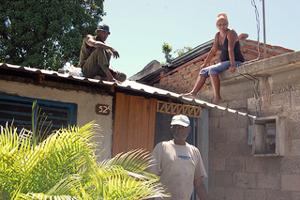
Roofs donated by Caritas Cuba programme. In Cuba, there was extensive coastal flooding and wind damage inland after Hurricaine Sandy in October 2012, destroying some 15,000 homes, killing 11, and causing $2 billion (2012 USD) in damage. Caritas has asked by the government to help repair roofs.
Credits: Caritas Mexicana
“It was a terrible night” is the common response Santiago de Cuba residents give when asked about Hurricane Sandy. And then individual experiences are recounted, each painful and frightening.
Santiago is one of the largest cities on Cuba, situated on the eastern tip of the island, about 1000km drive from the capital Havana. It’s over one million inhabitants were severely affected when Hurricane Sandy’s made land fall with winds of over 185 km/h on the night 24 October.
Not only was the city damaged, but the whole province. Six months later the impact is still obvious to any visitor who travels through the neighbourhoods of Santiago or in places such as Songo La Maya, El Caney and others. You can still see damage as far as the mountains, where the hillsides with felled trees bare the scares of the disaster.
“Santiago de Cuba was a green place, there were trees everywhere,” said Ana María Navarrete Piñol, director of Caritas Diocese of Santiago de Cuba. “Now driving on the highway, the landscape is transformed. Villages invisible before are now standing unprotected by trees. I think it will grow back, but it will take years. Sandy swept away all the beautiful trees”.
The damage was caused in just five hours of devastating violence. The absence of roofs on a number of houses is more evidence of what Sandy did to this province. Nine people lost their lives and more than 170,000 houses were damaged or destroyed here.
The destruction extended to the provinces of Guatanamo and Holguin. In each provinces, homes, churches, crops and farms are still damaged.
“All crops were totally destroyed,” says Manuel Martinez Hernandez, Caritas director for the Diocese of Holguin. “Restoring the crops is one of the biggest challenges for many rural families. They have lost their livelihood and will need support to regain their future lives.”
The impact of Sandy in Guantanamo and Holguin provinces is similar to that experienced by the inhabitants of Santiago de Cuba. “Diocese of Guantanamo has many damaged homes, but the most affected municipalities were El Salvador, Nicetas Perez and south of San Antonio,” said Maribel Sanchez, director of Caritas of Baracoa Guantanamo.
“The days go by and the homes still remain roofless. The rainy season has already started. By 1st June, the hurricane season begins and will continue until November. We could get hit by another storm this year too. We are extremely concerned by the fact that hundreds of families are still homeless or without a roof,” said Piñol.
The Caritas Diocese of Santiago de Cuba has been providing roofs and cover to 576 families in the town of Songo La Maya, where at least 4000 families suffered heavy losses to their homes.
According to Piñol, Caritas has prioritised helping populations not covered by the government.
“It is the government who allowed us the space to operate and in this particular case we were told we needed to assist with roofing,” she said. “Undoubtedly we will need help.
Rebuilding a city of over a million people is not an easy task and it can’t be done in three or six months. We were all affected by this disaster, including Caritas staff. One of our drivers was without a roof, another one lost her kitchen and yet they went to help other people in worse conditions”.
“The reconstruction of housing is a must. Families need housing. There are people who are living in deplorable conditions, people need a place to live, housing reconstruction is our top priority,” she said. “Through our parishes and hundreds of volunteers we have brought food, clothing, blankets, mattresses and more to thousands of people.
“All this support has been possible thanks to the solidarity of the Cuban people themselves through their respective parishes and the cooperation of Caritas confederation members, the Mormons, the Archdiocese of Miami, Christel Wasiek Foundation and others. But there is still much to do.”
